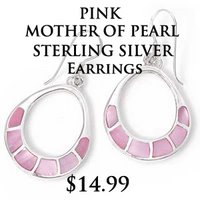Facts Of Mother Of Pearl Silver Jewelry
 Mother of Pearl is made of crystal calcium carbonate and conchiolin, secreted by the living organism within a mollusk, which slowly builds up and solidifies coating the inner surface of the shell. Mother of Pearl is also known as Nacre, from the Arabic word Naqqarah meaning shell.
Mother of Pearl is made of crystal calcium carbonate and conchiolin, secreted by the living organism within a mollusk, which slowly builds up and solidifies coating the inner surface of the shell. Mother of Pearl is also known as Nacre, from the Arabic word Naqqarah meaning shell.All waterborne organisms living within shells, called mollusks, have the ability to produce Mother of Pearl. However, very few mollusks with single shells, called gastropods, do so. High quality Mother of Pearl is produced by the mollusk family called bivalves, which have two-part shells.
The popular belief that Mother of Pearl and Pearl are formed as a result of a grain of sand entering a mollusks shell is false. Both Mother of Pearl (Nacre) and Pearl form when an organic irritant such as a parasite or food-particle become trapped within the mollusk, or if the mollusk is injured in some way.
Sensing the object the living organism within the mollusk secretes calcium carbonate, a derivative mineral of aragonite, and the binding protein conchiolin. These are the same substances that the animal uses to build its shell. The layers of calcium carbonate settle on the intruder, and are interspersed by the conchiolin, which acts as a kind of organic glue binding the crystals together. The regularity of the crystals, and the number of layers result in giving the Mother of Pearl (Nacre) or Pearl what is called luster.
Mother of Pearl Luster
Luster is a phenomenon used to describe the diffraction of light from the Mother of Pearl’s surface brilliance, together with its inner, deeper radiance. The radiance is the light that is reflected, not just off the surface, but also off the internal layers. A better luster is achieved if the Mother of Pearl crystals are uniform and the layers thin and numerous, letting the light diffract uninterrupted. Mother of Pearl that has a bright mirror like finish commands higher prices, whereas cheaper quality has a low luster appearing dull with a flat finish. The quality of the Mother of Pearl luster is also dependant on external factors.
Mother of Pearl is the creation of a living organism and environmental factors play a crucial role in its formation. Mother of Pearl producing mollusks cannot regulate their body temperature, and so are susceptible to changes in external conditions.
If the waters reach a high temperature of 30 degrees Celsius, as in the Pacific, the mollusks metabolism is increased and they grow faster secreting more Mother of Pearl than a mollusk who lives in colder waters. However, the layers of Mother of Pearl are thick, not as translucent and the crystal structure imperfect resulting in a duller, less lustrous Mother of Pearl. Therefore, Mother of Pearl is rarely harvested in the hotter summer months.
But when temperatures go down to 16 degrees Celsius, the mollusks metabolism is low, and produces nacre at a slower rate. These nacre layers are thinner, and the crystal structure more even, resulting in an increased translucency and better luster.
The term iridescence is often appropriated to Mother of Pearls as well as to opal. Iridescence is a general expression used when describing the presence of a rainbow effect across the surface; this is produced by the interference or diffraction of light through the gems crystal structure.
Mother of Pearl Color
Mother of Pearl, or Nacre appears in a variety of colors from white to black, and nearly every other color in between. It derives its color from three sources: genetic make-up, food and other trace metals in the water and finally to a lesser extent the depth and salt content of the water.
The mollusks genes are in part responsible for the color of the Mother of Pearl. A rainbow lipped, or black lipped oyster instinctively creates darker colors, whereas a white lipped oyster makes lighter colors.
Mollusks are filter feeders, sucking water in with their valves, extracting minute food particles from the water then ejecting the water out. Their diet consists of Phytoplankton, microscopic algae; these algae differ according to season. In the Gulf of California the blue green algae called Cyanophites are abundant in winter, but in summer a golden algae called Diatoms are more common. These different Phytoplankton provide the mollusk with materials that change the color of their Mother of Pearl.
Some trace elements are acquired from the water, such as metallic ions, that help the Mother of Pearl gain its unique coloration. Iron can give a pink color, copper a green to blue hue, magnesium a yellow coloration etc.
Mother of Pearl Care
Mother of Pearl is a hydrated gemstone, so it is essential to keep it away from direct sunlight, strong sources of heat or very dry atmospheres. If Mother of Pearl is left to dry out, its surfaces crack, and it becomes less resistant to ware and tear. Never use strong abrasives or alcohol to polish your Mother of Pearl, as this will destroy its play of color.
Store your Mother of Pearl in a dark cool place, and keep it looking its best by wiping it occasionally with a damp cloth. Wear it often; Mother of Pearl loves the bodies natural oils. The Nizams of India, famous for their pearl treasures, used to adorn their court eunuchs with pearls as their body oils kept the pearls in perfect condition…now there’s an idea!
Copyright © www.silvershake.com. All Rights Reserved.
This article was written for the Silvershake website, an online retailer of sterling silver jewelry at wholesale prices. See 100’s of mother of pearl silver rings items at prices 80% below normal retail prices. Make one purchase per month and receive silver jewelry worth up to $60...Absolutely free, everytime!



